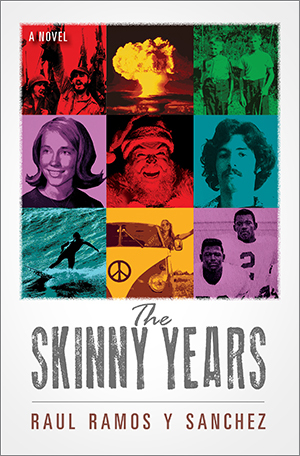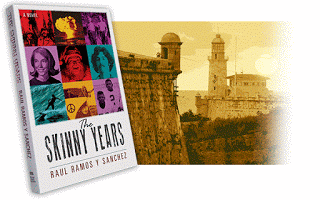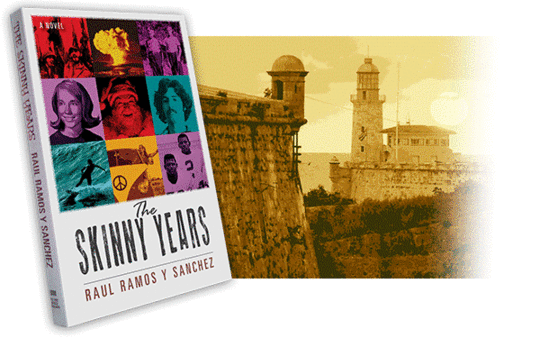Raul Ramos y Sanchez's Blog, page 5
June 21, 2016
Recent Reader Reviews - The Skinny Years

One week after the official launch of The Skinny Years , I'm thrilled to see the reviews from readers growing each day. Below are excerpts from the most recent reviews with links to the complete text.
"A great read with plenty of American heart and lots of Latino soul."
Dom Cimei - Full review
"Richly rewards the reader for the journey taken."
Sara Templeton - Full review
"Adds another important patch to that which we call the great American quilt of migration."
Jesse Luna - Full review
"An entertaining and thoughtful slice of life."
Kate Hagebuch - Full review
"A lovely tale of the past. Well remembered, told with lots of amor."
Belinda Osorio - Full review
My deepest thanks to everyone who has taken the time to share their thoughts about my fourth novel.
Raul Ramos y Sanchez

[image error]
Published on June 21, 2016 01:23
June 5, 2016
Which parts of The Skinny Years are real?
 The Skinny Years is set in Miami during the stormy 1960s. Since I grew up in the same place and time, a number of readers have asked, "Which parts of the novel are real?"
The Skinny Years is set in Miami during the stormy 1960s. Since I grew up in the same place and time, a number of readers have asked, "Which parts of the novel are real?"The characters in The Skinny Years are composites of friends, enemies, neighbors and schoolmates from my adolescence. A few real-life experiences of my own are woven into the story as well. (However, I am not the main character, Skinny, as anyone who knows my personal history can attest.) The result is a mashup of the real and the imagined, from the past and from the present, concocted into a narrative that's hopefully interesting. In other words, it's fiction. But a lot about the era and the area in the novel are very real.
 Miami's skyline in the sixtiesAll of the South Florida geographic details in the book are accurate: the neighborhoods, the streets and causeways, the schools, even the bus lines. Many have changed since the sixties, however. The areas most transformed are South Beach and Wynwood, the neighborhood where much of the novel takes place.
Miami's skyline in the sixtiesAll of the South Florida geographic details in the book are accurate: the neighborhoods, the streets and causeways, the schools, even the bus lines. Many have changed since the sixties, however. The areas most transformed are South Beach and Wynwood, the neighborhood where much of the novel takes place.South Beach was once a backwater appendix to Miami Beach dubbed "God's waiting room" because of its many retirees lingering near death. It was also a surfing hangout for local teens. Today, as everyone knows, South Beach is a hip and vibrant district for the hard body set.
Below is a view of South Beach as I remember it back in the day. The stretch of coast between the pier and the jetties are the setting for several scenes in the book.
 The original "South Beach" of the 1960sIn the novel, Skinny's neighborhood of Wynwood is described as "a tightly-packed grid of small houses and apartments—a low-rent area where the cooks, cabbies, mechanics, and maids whose labor greased Miami’s tourism machine rested their heads and raised their kids." The Wynwood Arts District, as it's known today, is a collection of trendy art galleries, antique shops, bistros and a few luxury high-rises. Wynwood now bills itself as "the go-to place for an alternative and more cultural nightlife in the City of Miami." Some have called it the South Beach of the mainland. Nearly fifty years later, color me stunned.
The original "South Beach" of the 1960sIn the novel, Skinny's neighborhood of Wynwood is described as "a tightly-packed grid of small houses and apartments—a low-rent area where the cooks, cabbies, mechanics, and maids whose labor greased Miami’s tourism machine rested their heads and raised their kids." The Wynwood Arts District, as it's known today, is a collection of trendy art galleries, antique shops, bistros and a few luxury high-rises. Wynwood now bills itself as "the go-to place for an alternative and more cultural nightlife in the City of Miami." Some have called it the South Beach of the mainland. Nearly fifty years later, color me stunned. Wynwood todayOther Miami areas included in The Skinny Years are Liberty City and Overtown. These are still predominantly African-American neighborhoods. I'm happy to say Overtown is making strides toward a renaissance of the post-war area when it was a hotbed of commerce and entertainment.
Wynwood todayOther Miami areas included in The Skinny Years are Liberty City and Overtown. These are still predominantly African-American neighborhoods. I'm happy to say Overtown is making strides toward a renaissance of the post-war area when it was a hotbed of commerce and entertainment.The sixties were a turbulent time. Anyone who lived through the era will remember some of its most vivid milestones: the Cuban Missile Crisis... the Civil Rights movement... the dawning of the youth counterculture... In Miami, these events were especially intense. The Skinny Years offers an intimate, Latin-flavored perspective into this social history.
If you have specific questions about the novel, its characters and events, please contact me directly. I will answer you privately to avoid spoilers for those who have not read the book.
I look forward to hearing from you.
Raul Ramos y Sanchez

[image error]
Published on June 05, 2016 13:55
May 30, 2016
The Beatles: A seismic change during the 1960s
The Sixties: The British Invasion - The Beatles arrive at JFK from Jonathan Buss on Vimeo.
If you lived through it, you'll never forget it.
As a kid, you knew the Beatles were different than any musicians who had come before. It was a seismic change.They were the first and the biggest of The British Invasion of the 1960s.
Raul Ramos y Sanchez

[image error]
Published on May 30, 2016 01:31
May 28, 2016
Foreword Reviews on The Skinny Years: "Gritty and witty"
Posted March 27, 2016 on
Foreword Reviews by Monica Carter
:


The Skinny Years
A family flees from Castro’s Cuba, in this gritty, humorous novel about a young boy’s coming of age.
Raul Ramos y Sanchez’s The Skinny Years is a complex, humorous, and utterly absorbing coming-of-age tale set in the 1960s. With themes of friendship, family loyalty, and economic hardships, the novel explores a decade in the life of eight-year-old Victor “Skinny” Delgado. The novel opens with Victor’s father, Juan Delgado, and his family living a life of luxury and success in Havana. As a professor of law at the University of Havana and a top supporter of the Batista regime, Mr. Delgado is proud of his anticommunist essays, but when Fidel Castro takes over, Batista and his defenders flee Cuba for their own protection.
Mr. and Mrs. Delgado, Skinny, his little sister Marta, and his maternal grandmother are left with little money when they arrive in Miami. Forced to live in a small house, with roaches as roommates, Mrs. Delgado takes a job as a hotel maid to support the family. Mr. Delgado refuses to work, convinced that Batista will regain power and the family’s former riches will be restored. With the constant negative undertow in his home, Skinny decides to spend most of his time out in the neighborhood.
When Loco, a local kid with red, bushy hair, saves the overweight Skinny from getting into a fight at the park, they become loyal friends. Loco is also Cuban and helps Skinny adapt to some of the cultural differences. Ramos infuses the novel with comical teaching moments, as when Loco takes Skinny trick-or-treating for the first time. Skinny informs Loco that he will not wear his mother’s scarf when they dress up as pirates, but Loco advises Skinny to “cut the macho act … this isn’t Cuba. Nobody here is going to think you’re a maricón for wearing a scarf on Halloween.”
Ramos has written a realistic, gritty, and witty coming-of-age story that focuses on not only Skinny’s growth, but the growth of all the characters. This well-written novel about the Cuban experience in 1960s Miami offers a much-needed perspective to that era of American history.
********
See the original on Foreword Reviews
Raul Ramos y Sanchez

[image error]
Published on May 28, 2016 19:07
•
Tags:
coming-of-age, fiction, humor, novel
May 25, 2016
Advice to aspiring writers

The folks at Goodreads recently asked...
What's your advice to aspiring writers?
My reply:
Write. Write. Write. Then re-write what you've written. Once you have a complete work that you are proud of, get a professional editor to improve it. Next, find an agent who believes in your work. You can do this online, through the mail or at a writers' conference. I recommend the latter. After all this, expect to be rejected. There is one thing all published writers have in common: persistence.
Are you an aspiring writer? Have a question about writing? Drop me a line. Like most writers, I'm glad to share the craft.
Raul Ramos y Sanchez

[image error]
Published on May 25, 2016 15:25
May 22, 2016
The things we leave behind define who we are
 Silvio Sirias is the award-winning author of the novels Bernardo and the Virgin, Meet Me Under the Ceiba, and
The Saint of Santa Fe.
A review of The Skinny Years by Silvio Sirias
Silvio Sirias is the award-winning author of the novels Bernardo and the Virgin, Meet Me Under the Ceiba, and
The Saint of Santa Fe.
A review of The Skinny Years by Silvio Sirias"The things we leave behind play a significant role in defining who we are. Moreover, as youth, what life forces us to jettison helps to give shape to the adults we become." This how award-winning author Silvio Sirias begins his review of my new novel The Skinny Years .
The conclusion of Sirias's review left me feeling gratified.
"In The Skinny Years, a highly readable coming-of-age tale, Ramos y Sánchez assures readers that when immigrants are allowed to leave behind their former selves at their own pace, renovated identities will emerge. And although these new “Americans” will carry the bruises of their efforts to assimilate, most become grateful and wise contributors to the continuing saga of the United States of America."
You can read the complete review at Silvio's blog, Tropical Perceptions.
With the often-bitter debate over immigration taking place in the U.S. and throughout the world, I am grateful to Silvio Sirias for his insights and wisdom.
 The Skinny Years is now available in paperback, hardcover and e-book on Amazon. More distribution sources will follow.
The Skinny Years is now available in paperback, hardcover and e-book on Amazon. More distribution sources will follow. Raul Ramos y Sanchez

[image error]
Published on May 22, 2016 05:02
May 19, 2016
Rebecca Coffey's review of The Skinny Years
 Rebecca Coffey is a science journalist, humorist and the author of several books. She contributes to Scientific American and Discover magazines, as well as to McSweeney's Internet Tendency and The Rumpus. She blogs for Psychology Today and is a frequent guest on talk shows including her on-air commentary for Vermont Public Radio.
Rebecca Coffey is a science journalist, humorist and the author of several books. She contributes to Scientific American and Discover magazines, as well as to McSweeney's Internet Tendency and The Rumpus. She blogs for Psychology Today and is a frequent guest on talk shows including her on-air commentary for Vermont Public Radio.  Her latest novel,
Hysterical: Anna Freud's Story
has garnered glowing reviews from Booklist, Kirkus Reviews, Library Journal, LAMDA Literary, and the project director of the Freud Archives, to name a few. So Rebecca’s take on The Skinny Years was reason for elation by its author. Here is her full review:
Her latest novel,
Hysterical: Anna Freud's Story
has garnered glowing reviews from Booklist, Kirkus Reviews, Library Journal, LAMDA Literary, and the project director of the Freud Archives, to name a few. So Rebecca’s take on The Skinny Years was reason for elation by its author. Here is her full review:
"Raul Ramos y Sanchez’s The Skinny Years reminded me how precarious world events could make life in the 1960s feel. The “Skinny” of the novel’s title is a pudgy Cuban immigrant boy, a perennial outsider looking in. He’s got his mind and heart focused safely on the sweet, beautiful rich girl in his class. Meanwhile his peripheral vision catches an onslaught of very real calamities. The many humiliations of poverty. Pervasive racism and jingoism that, as a white Cuban in Miami, he can almost sidestep. The Bay of Pigs. Slaughter in Vietnam. Classroom safety movies about how to survive nuclear holocaust. Triggers like these conspire to drive Skinny ever more deeply into an almost carnival-like circle of naysayers, druggies, and dreamers. The Skinny Years is as nervy and improbable as Oliver Twist and The Goldfinch. And that’s saying a lot."
-- Rebecca Coffey, author of Hysterical: Anna Freud's Story.
I want to thank Rebecca for her kind words and for taking the time to review The Skinny Years.
Raul Ramos y Sanchez

[image error]
Published on May 19, 2016 07:23
May 5, 2016
Preview: The Skinny Years
New coming-of-age novel available in June
My fourth novel, The Skinny Years, is quite different from the Class H Trilogy. It's more personal and closer to home. I hope this coming-of-age story set in the stormy sixties reminds readers of every generation that the path out of innocence is always a one-way journey—and one we never forget.

A synopsis of The Skinny Years:
Surfers, soul brothers, hippies, and thugs— they’re all part of Victor “Skinny” Delgado’s world growing up in Miami during the turbulent 1960s. Fleeing the Castro regime in Cuba, Skinny’s once-wealthy family moves from a mansion in Havana to a roach-infested bungalow in Miami’s low-rent Wynwood district. Over the next ten years the Delgados struggle to survive in this strange new land—a place where fat men in red suits enter your home through the chimney, demons appear at the door begging for candy, and young women go on dates without chaperones. There’s only one constant in Skinny's world as he grows from 8 to 18. He longs in vain for the girl of his dreams: his neighbor Janice Bockman who seems everything American—and everything he’s not.
Advance reviews:
"Vivid, engaging, well-paced, with compelling characters. A terrific book." — Ralph Keyes, best-selling author of Is There Life After High School?
"As nervy and improbable as Oliver Twist and The Goldfinch. And that's saying a lot." — Rebecca Coffey, journalist, humorist and author of Hysterical: Anna Freud's Story
Coming in June. Want a reminder email?
If you'd like to get an email reminding you when The Skinny Years has been released please click here .
The novel will be available in hardbound, paperback and eBook editions.
I look forward to hearing from you!
Raul Ramos y Sanchez

[image error]
Published on May 05, 2016 00:19
April 9, 2016
I Tend a White Rose

Cultivo Una Rosa Blanca (I Tend a White Rose) is perhaps the best-known work of Cuba’s most beloved patriot and poet, Jose Marti. In Spanish, the poem’s simple words are powerful and inspiring. Yet I’ve never been nearly as moved by its many English translations. So I will toss my hat into the ring. Whether you are bilingual or not, I hope you’ll let me know what you think of my version.
I Tend a White Rose
I tend a single white rose
in summer as well as winter,
for the true friend who will extend
an honest hand in peace.
And for the foe who would tear
the living heart from my chest,
thistle nor thorns do I sow,
I tend a single white rose.
Cultivo Una Rosa Blanca
Cultivo una rosa blanca
en junio como en enero
para el amigo sincero
que me da su mano franca.
Y para el cruel que me arranca
el corazón con que vivo,
cardo ni ortiga cultivo;
cultivo la rosa blanca.
Little known outside Cuba, Jose Marti was a patriot, a poet, and most of all, a humanitarian.
Raul Ramos y Sanchez

[image error]
Published on April 09, 2016 05:24
March 27, 2016
Do you cringe when recalling high school?
Do you cringe when recalling your high school years? You may be surprised to learn you’re not alone after reading best-selling author Ralph Keyes' updated classic “Is There Life After High School.”

The latest edition contains new research on the high school experiences of public figures like Barrack Obama, Donald Trump, Hillary Clinton, Katie Couric, George Clooney, Lady Gaga, Brad Pitt, Angelina Jolie, and many more.
One of my favorite nuggets from the book:
"Is There Life After High School" is currently available as a Kindle edition.
Raul Ramos y Sanchez

[image error]

The latest edition contains new research on the high school experiences of public figures like Barrack Obama, Donald Trump, Hillary Clinton, Katie Couric, George Clooney, Lady Gaga, Brad Pitt, Angelina Jolie, and many more.
One of my favorite nuggets from the book:
When a high school tormentor came to congratulate Mike Nichols after his standup act, Nichols asked the former bully what he was doing now.If you’re a few years beyond those hallways filled with lockers and adolescent angst (or even if you're still in high school), you’ll find this an enlightening and enjoyable read.
"I'm selling used cars," said the tormentor.
"I'm so glad," said Nichols.
"Is There Life After High School" is currently available as a Kindle edition.
Raul Ramos y Sanchez

[image error]
Published on March 27, 2016 20:42



